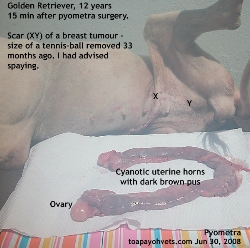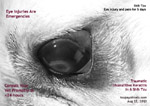This was not good news. Flies are attracted to decaying flesh as moths are to candle light. Kamikaze flies who just cannot resist necrotic flesh.
The 12-year-old Golden Retriever had some vaginal discharge 2 months ago. The grandmother attributed it to the dog having heat. In the last 4 days, the dog passed out thick glue-like mucus from her vagina. She stopped eating for 2 days and had vomited.
"Your dog had a severe womb infection. She vomited because toxins could have damaged her kidneys and internal organs, " I did not give much hope of survival for this dog. "Why didn't you spay the dog after the breast tumour operation?"
My past procedure was to remove the breast tumour first and then spay the female dog later. In this way, hormones feeding any new breast tumour would not be available after removal of the ovaries.
The slim and fair grandmother laughed: "You said that Rover would not survive 9 months as her cancer could have spread to her body. Can you recall? breast cancer was as large as a tennis ball!"
I checked my records. It was September 2005 when the large breast tumour was removed. It was a solitary gigantic lump as large as a tennis ball. Now, in Jun 2008, the dog had a long scar where the tumour was. There was a small breast tumour around 2 cm in diameter.
My 'prediction' of 9 months' of life for this Golden Retriever had been way off the mark. It was now 33 months after tumour removal. Why would I give a definite 9 months, I cannot remember. Why not 3 months or any other number? No vet can foresee the future. But I did not argue as the grandmother had a sharp memory.
Now the dog was very sick. She had fever of 40.5 degrees C. She was not eating. She yelled in protest of great pain on the operating table when I stretched her legs to see the long 15-cm scar of the tennis-ball-sized breast lump.
She was now in poor health. If flies just zeroed into her vaginal discharge, it indicated that her womb tissues had rotted. Flies are suicidal and sticky when the tissues and discharges stink a lot. They seem to appear from nowhere and are large bodies flies from the vegetation near the house.
 The
grandmother understood the big risk of dying on
the operating table. I boarded the dog one day to
give her antibiotics, anti-fever and drips. The
dog felt good 24 hours later and ate a full meal
after canned food was added.
The
grandmother understood the big risk of dying on
the operating table. I boarded the dog one day to
give her antibiotics, anti-fever and drips. The
dog felt good 24 hours later and ate a full meal
after canned food was added.
Now I had to
decide. To operate 36 hours after admission or
wait another day? The infected womb might rupture
anytime as it was decaying. Her temperature had
dropped to 37.5 degrees C, one degree below
normal. She was sleepy and lethargic. This was a
life and death situation. If the surgery was
delayed another day, she would die due to toxic
blood infusing her whole body. If the surgery was
performed, she might die on the operating table as
chances of survival were deemed below 50%. So,
which decision to make?
The dog was given just gas anaesthesia and
intubated. Her large thin-walled uterus and
ovaries were removed. The reddish brown pus was
copious. Bacterial toxins had seeped into the
blood system by permeating past the uterine walls.
The uterine horns were purplish in colour when the
normal ones would be light pink.
The dog survived the surgery. After waking up, she
vomited a big mass of food on the operating
table. I had taken out the endotracheal tube some
2 minutes ago.
This was an abnormal event as she had been starved
>12 hours prior to surgery and should not vomit
anything. This indicated that the stomach was not
moving the food along the gut. Another abnormal
feature was the dark bluish black blood of
her omental blood vessels. Normally they would be
reddish.
Such negative signs were not good for the dog. I
phoned the grandmother to come to see the dog
after surgery which was completed around 11 am. I
assessed that this dog would not survive and it
would be good for the grandmother to see her. She
was the dog that brought newspapers to the
grandmother every morning and kept her company.
However the grandmother's two adult sons needed
her at the airport - one going abroad and one
returning to Singapore.
At 7 p.m, the Golden Retriever just passed away
quietly due to heart failure. Her gums and tongue
were cyanotic. We informed the grandmother. She
came around midnight.
5 days later, the grandmother came to pay the
bills. "My daughter said there would be nobody in
your surgery during lunch-time," grandmother said.
"But there ought to be somebody."
The grandmother was correct. I had just returned
from visiting abalone farms in Xiamen, China.
The grandmother was sad in her heart. Every dog's
death is sadness for everyone involved. I asked
grandmother to sit down and we reminisced in the
consultation room. Just to know more about Rover.
Grandmother said, "Rover dog behaved strangely the
night before going to the vet. She dog walked
around the house and went to the back garden to
stroll by herself."
"Does Rover not wander around usually?" I asked as
the bungalow would have ample garden for her to
roam.
"No," grandmother said. "Rover does not go to the
back garden by herself at night."
"She also went to my daughter's bedroom to sit and
wait patiently."
"Why would she do it?" I asked.
"She waited till my daughter gave her a second
piece of Pokey biscuit. My daughter said to her
'You are permitted only one Pokey biscuit. Go
away. Mommy will scold me,'" the daughter told
Rover off.
"But Rover would not go away. My daughter gave her
a second Pokey biscuit stick and after eating it,
Rover left."
Was the dog saying good-bye to the family members
and the house? It is hard to explain such unusual
canine-human interaction. As if there was a
farewell communication between old companions.
Some animals might know that their life would be
ending soon and wanted to say good-bye.
The grandmother stoically said to me: "My grandson
keeps asking when Jesus will bring Rover back."
The 5-year-old was too young to understand that
death was permanent.
Would spaying her when she was younger prevent
pyometra and prolong her life? Without the womb,
she would not have pyometra and therefore would
live to a ripe old age of another year or two? It
is hard to say. Anaesthesia in dogs older than 8
years are high risk.
No vet can be assured of 100% survival in such
cases. Sometimes it is best to pass such high risk
cases to other vets. The daughter still grieved
her loss daily for the past 5 days. "I guess she
would be angry with me," I said to the
grandmother. No comment from her.
The grandmother was stoic. Her friend had just got
a stroke. She was widowed some 2 years ago and had
now fortified herself.
"This dog was adopted as a puppy when there was a
newspaper advertisement in the Straits Times
looking for homes for the puppies to be given
free," grandmother recalled. "I saw the
advertisement when the newspapers were delivered
at 5 am. Usually papers come at 7 am. So I went
with my two sons and the owner gave us Rover.
Rover used to bring the newspapers into the house
every morning."
The grandmother had lots of work to do with so
many dogs and children. "At one time, I looked
after 8 dogs. Friends asked me to care for them
for a while. They just did not come back for the
dogs. I have 3 children to cook for and look
after."
What an active energetic life, grandmother must
have had. Though she was now 65 years of age, she
looked much younger and trimmer than a
50-year-old. Usually grandmothers look matronly
but she was a model for the slimming saloons.
"I cured one terrapin with enlarged closed eyes
just by researching the internet," the grandmother
said to me. That was great news. Most Singapore
women of her age would not touch the computer.
"I can remember important dates and do
calculations fast," the grandmother reminisced. "I
would tell my children the price per kg for things
they bought. But lately, I am not able to
calculate so well."
It was good that she came during lunch time as we
had some time to talk about the dog. "I can't stay
long to chat," grandmother suddenly saw that time
had passed so fast. "I have to go to Hong Kong,"
"Why do you have to rush to Hong Kong?" I
appreciated the grandmother taking the trouble to
pay the bills without being asked to do so.
"To look after my grandson for a week while my son
and his wife had to go on holidays" she said.
"There are two maids looking after him too."
All grandsons must surely love her very much but
the one who loved her the most was the 5-year-old
boy who stayed with her in Singapore. This
5-year-old boy came with the grandmother during
the consultation and later around midnight to see
the dog. A fair-looking boy with big eyes. He
asked his grandmother for the past days with
questions the grandmother told me, such as:
"Why Jesus take away Rover?"
"Why Rover has not come home?"
"Only one (pre-school) classmate knows when I said
that Rover had gone to see Jesus."
The grandson had come with the grandmother during
consultation as his pre-school had closed due to
the presence of hand-foot-and-mouth disease
prevalent in Singapore at this time.
It is extremely high risk to operate on toxemic
pyometra and old dogs. If the owner had returned
to get the dog spayed one or two months after the
breast tumour removal in 2005, this dog might
still be alive. She might have died during the
spay surgery too but the probability of her dying
on the operating table when she was 10 years old
would be much lower.
Singapore owners generally have not reached a high
level of awareness stage that the dog must be
spayed after removal of the breast tumour. They
just forget about the spay once the tumour is
removed. It is not prudent to remove the breast
tumour and spay at the same time in old dogs as
the prolonged anaesthetic time increases the risk
of death on the operating table and so I do not
perform dual surgeries at the same time as some
vets would do so. The risks of deaths are simply
too great for the older dog.
My present procedure would be to spay the dog
first. If the owner did not return to get the
breast tumour removed 2-4 weeks later, the female
hormones feeding and growing the tumour would be
removed as the ovaries would be taken out during
the spay. Ideally, spay and mammary tumour removal
should be done at the same time. But the surgery
would take a long time and at the end of the long
surgery, the dog might die on the operating table.
No family member can forgive or forget a death on
the operating table. So it is best not to take
foolish risks.
CASE 2 IN
2011. PYOMETRA IN A 6-YEAR-OLD GOLDEN RETRIEVER
July 7, 2011
I have been searching the internet (googled
"pyometra in old dogs") for my past cases of
pyometra in a Golden Retriever as I had one case
recently. This Golden Retriever was passing pus in
large amounts and was not eating. The dog was
operated on it late at night as the floor was
flooded with more vaginal discharge of pus.
I intended to wait and see after giving an
antibiotic and anti-fever injection and drip in
the morning to bring down the fever. The dog's
temperature had dropped to below normal and she
was lethargic again. Another IV drip was given and
she was operated as an emergency. I had not phoned
the owner prior to surgery on that night. I had
informed the owners that the dog needed to be
operated on within 7 days in the morning.
The next evening, I sent her home when the owners
arrived to visit. She vomited on Day 3 and I asked
the owner to bring the dog back for review and
treatment just to be sure that there was no
post-operation complications.
At the surgery, the dog was alert and normal.
After one day of hospitalisation, she went home
and there were no more complaints as at today (5th
day after surgery).
The reason I write this case is to advise other
vets of my experience in this case when I asked
the owner to come back for review when he
complained that the dog had vomited. It was a
remark made by one angry lady in her 30s who said:
"How would my old mother know what you show her?
For all I know, it could be intestines! This
implied that I had been dishonest to show some pig
intestines which are easily available for sale at
the wet markets.
I had said that the dog was suffering from a womb
full of pus and had performed an emergency spay.
It was my fault for not phoning first before the
surgery. I did not make any excuse. I had to bear
the responsibility of what the family members
would want to do as a consequence including
financial compensation.
The big sausage-like uterine horns were kept on a
plate and covered up. When the mother and
her adult son came the following evening, they
were shown the plate and asked if they wanted to
see the womb covered up by paper. They declined.
In retrospect, I should not have the plate covered
up so that the mother and the adult son really saw
the womb of their dog.
|
To
improve Toa Payoh Vets' veterinary services,
there are 5 tips for vets as regards the
management and client communications in
pyometra in dogs: 1. It was best not to release the dog home 24 hours after surgery as was my decision in this case. I thought the dog would be better cared for at home in this case. Poor judgments do occur. 2. Also, every attempt must be made to phone the owner prior to any emergency surgery even though the owner had consented to the surgery to be done soon. This is to prevent misunderstandings and anger from some family members who were not present at the first consultation. This Golden Retriever is OK but if she had died on the operating table, repercussions would be terrible for me as I should have waited till phone consent was given. An informed consent form should be signed in all cases of surgery and hospitalisation to protect the vet. 3. Phone the owners immediately after surgery. This may not be practical advice but it is best done as soon as possible. 4. Send written reminders or phone the owner and record this down in the case card, after breast tumour removal, to ask the owner to get the female dog spayed as well (to prevent pyometra or more tumour formation). 5. Show the infected womb without covering it up with papers, but know that some clients do not want to see the blood and the gore. |
P.S
For interested readers, the google search result
for "pyometra in old dogs" was my blog at:
http://veterinarymedicinesingapore.blogspot.com/2008/06/3-pyometra-in-old-female-dogs-to-spay.html
 TOA
PAYOH VETS
TOA
PAYOH VETS

